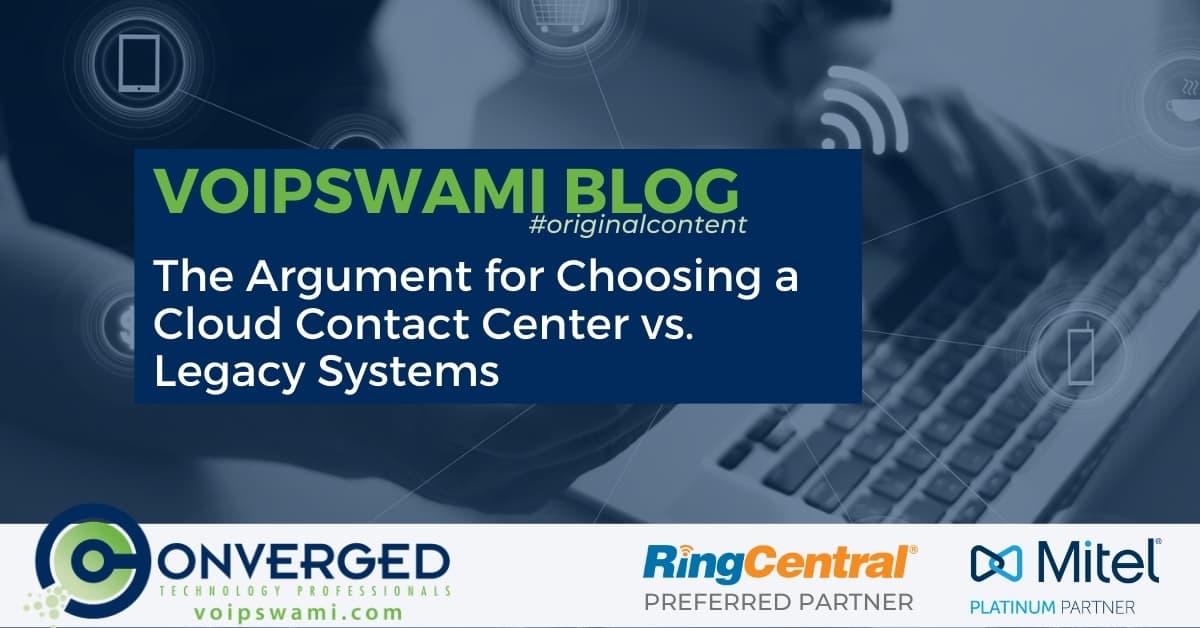
IT and contact center managers are turning to technology that enables their teams to collaborate more efficiently, and service customers through multiple channels. The ROI of any such investment enables managers and agents to make better decisions and to unlock future successes in a digital world.
In this article, we discuss the differences between an on-prem contact center solution and those hosted in the cloud. Which is better for you? We'll dive into some key elements for why cloud solutions hold advantages over legacy solutions.
Understanding the difference between on-premise and cloud contact centers
Every aspect of the traditional onsite call center is stored within your place of business. In-house IT teams are responsible for installing and maintaining everything from phone servers and applications to the headsets.
By contrast, cloud-based call center solutions are hosted in the cloud and managed by a cloud provider, which should free up your IT teams to handle more value-add activities in your business. It’s important to keep in mind that its success will depend greatly on the quality of your internet connection to accommodate every user and increasing list of bandwidth-hungry applications, emails, online activity, etc.
Questions around security and additional expenses might have held you back previously from making the leap to the cloud. But the reality is that almost every element of an on-prem contact center can be dramatically improved by migrating to a cloud solution. Your infrastructure setup, cost reduction, additional features, greater integration, and increased reliability are just a few examples of the improvements that can be unlocked by moving away from a traditional on-premise solution.
And once again, your IT team can be freed up to focus on more network related issues like data security, rather than dealing with ongoing maintenance and upgrades and testing of your on-prem solution. Not to mention many cloud providers offer their own support for troubleshooting, which takes the burden off your IT team.
Contact Center Flexibility & Scalability
The annual turnover rate for contact center agents is more than double the average of all other occupations. But it also creates a strain on existing resources who are tasked with removing user accounts, adding and configuring new agents or managing licenses.
Thankfully, many of these headaches are removed, and tasks are much easier to manage in cloud platforms.
When moving from on-premises to cloud contact center technology, many leaders will be motivated by the ROI of a solution that allows you to buy for what you need and add in more as you grow.
One of the universal problems for contact center managers is how call levels can fluctuate because of business demand and seasonal variations. Although no two days are the same, on-premise contact centers typically involve fixed and rigid costing.
Cloud solutions make it possible to flex your capacity as and when you need additional resources. But, being able to flex back down is equally as important to ensure that you only pay for what you use. Make sure to work with your support partner to confirm any terms in the contract related to adding and removing post-signing of the contract as these vary from provider to provider.

Increased Efficiency with Cloud Contact Centers
The removal of restrictive and clunky hardware from expensive physical premises has understandably made the cloud an attractive alternative that reduces costs while also improving efficiency.
According to a recent report by Forrester, moving to the cloud can reduce the average handling time (AHT), improve first-call resolution (FCR), and give customer satisfaction a much-needed boost. These are just a few meaningful metrics that will enable you to measure your continuous service improvement journey and why 66% of contact centers are moving to the cloud in 2020.
Cost Savings Associated with Cloud-Based Solutions
On-premise call centers are time-consuming and come with a long list of responsibilities that prevent you from focusing on adding value to your business. Housing servers and additional hardware is just the beginning.
The maintenance operating costs, software updates, and hardware refreshes are all managed in-house. But wouldn't it be easier to invest your time and resources into making your call center more efficient?
By contrast, cloud call center users can be deployed in a matter of minutes and do not require any capital investment upfront.
From a costing standpoint, the time that technical teams spend on configuring in-house systems is far more expensive than many realize. In comparison, many cloud contact centers will have reliable softphones that are very low maintenance and don’t require the hard costs previously necessary with the on-prem solution.
In the cloud, technical teams are set free from the time-stealing activities that have prevented them from playing an active role in driving the business forward. It also makes it easy to transform a legacy contact center by leveraging the latest technology and enables teams to be more innovative.
Some companies are also guilty of neglecting their on-premise call center infrastructure and have a mindset of "if it isn't broke, don't fix it." But a cloud contact center will be managed by a service provider who will ensure that it is always using the most advanced and current version of the technology.
There are many examples of the collective opportunities created by migrating to the cloud that can also put the "R" in "ROI" for your cloud contact center.
Any modern contact center should continue to evolve with your business needs and the digital landscape. By simplifying your infrastructure, IT Management can finally get their valuable specialists helping the business thrive and grow by focusing on more significant issues instead of firefighting day-to-day maintenance tasks.
The Future of Where Contact Center Agents Work & Security
We are finally beginning to see the end of debates around working from home vs. in the office. Business leaders are thinking bigger and exploring how they can enable staff to work from anywhere. As a result of these changes, new company and HR policies are emerging that will allow hybrid options to make it possible for agents to work from anywhere.
New working environments will also create a few challenges around data security and compliance. But this is where a purpose-built cloud contact center eases the transition by enabling your chosen provider to manage your telecommunications and the responsibilities that come with it.
Cloud compliance will initially feel quite daunting. For example, The Sarbanes-Oxley Act (SOX) and the Financial Industry Regulatory Authority (FINRA) were designed to protect cloud data in the financial sector. But these are just two examples of critical certifications that would have previously been a headache to obtain and manage with a traditional in-house solution.
The burden of responsibility is taken away from the business by choosing the right contact center service provider who understands compliance issues and has the necessary certifications.
Migrating to a cloud solution is a great way to consolidate your contact center infrastructure and PBX. It can also help you streamline your list of vendors into one easy-to-manage provider that does all of the work that is currently draining your resources and providing little in terms of value.
However, as the workplace continues to evolve, a cloud solution enables your business to continuously add new functionalities such as workforce management, monitoring, and sophisticated analytics.
But you don't need to go all-in on the cloud.
If you are understandably cautious about the road ahead, maybe a hybrid approach for your contact center will give you a taste of the benefits available.
The answer will be different for each person reading this guide. But if you would like a conversation on what approach would be best suited for your business and help you reach your future goals, simply contact us for a free consultation and quotes.
If you enjoyed this article you may also enjoy:
